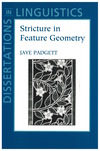This work represents an in-depth investigation into the pervasive interaction of place of articulation features and constriction degree features (stricture features) in phonological processes . The central claim, a development of Feature Geometry theory, is that place features and oral stricture features like [continuant] and [consonantal] form a phonological unit called the articulator group. This proposal finds motivation in a wide range of empirical areas, including place assimilation processes, complex segment contrasts, dissimilatory effects, spirantization and phonetic considerations. Theoretical topics of particular concern include the organization of phonological features, feature underspecification, feature cooccurrence conditions and structure preservation, the application of the Obligatory Contour Principle, and the phonetics-phonology inference.
Jaye Padgett was an assistant professor linguistics at the University of California, Santa Cruz at the time of this publication
- Preface
- Table of Contents
- 1 Background
- 1.1 Feature Geometry
- 1.1.1 Which Classes?
- 1.1.2 The ‘Standard Theory’
- 1.1.3 Organization of the Thesis
- 1.2 Feature Geometry and Phonetic Representations
- 1.2.1 Phonetics-Phonology Similarities
- 1.2.2 Phonetics-Phonolgy Differences
- 2 Stricture and Nasal Place Assimilation
- 2.1 Place Assimilation and [continuant]: Introduction
- 2.2 Structure Preservation and Marking Conditions
- 2.3 No Assimilation; Default Place Assignment
- 2.4 No Assimilation; Deletion of the Nasal
- 2.4.1 Zoque
- 2.4.2 Lithuanian
- 2.5 Summary of the Account
- 2.6 Apparent Counterexample
- 2.6.1 Gestural Overlap
- 2.6.2 The Marking Condition is not Enforced?
- 2.6.3 Hardening
- 2.7 An Alternative Principle?
- 2.8 Place Assimilation and [consonatal]
- 2.8.1 Failed Assimilation: Lithuanian
- 2.8.2 Assimilation with GLiding: Zoque
- 2.8.3 Assimilation with Hardening
- 2.9 Place Assimilation and [approximant]
- Appendix: the Representation of Prenasalization
- 3 Complex Segments
- 3.1 Stricture in Complex Segments
- 3.2 Kadardian Harmonic Clusters
- 3.2.1 Harmonic Clusters as Single Segments
- 3.2.1.1 Minimal Pairs: Harmonic vs. True Clusters
- 3.2.1.2 Regressive Articulation
- 3.2.1.3 Sonority
- 3.2.1.4 Harmonic Clusters and the Status of Schwa
- 3.2.1.5 More on the Distribution of Harmonic Clusters
- 3.2.2 The Representation of Harmonic Clusters
- 3.2.3 [cont] in Harmonic Clusters
- Appendix: the (Simple) Consonant Phonemes of Kabardian
- 4 Other Place Assimilations
- 4.1 Sino-Japanese Compounds
- 4.2 Havana Liquid Assimilation
- 4.3 Catalan Stop Assimilation
- 4.4 Other Cases
- 5 Implications and Alternatives
- 5.1 [cont] Spreading and Tierhood
- 5.1.1 [cont] as an Argument
- 5.1.2 Tiers and Ordering
- 5.1.3 [cont] Spreading in Spanish
- 5.2 The Articulator Group and place Underspecification
- 5.3 Stricture and Laryngeal Segments
- 5.4 Place and Stricture: Other Proposals
- 5.4.1 Supralaryngeal and Oral Cavity
- 5.4.2 ‘Place-Stricture Dependency’
- 6 Root Cooccurrence Restrictions
- 6.1 Place and Stricture in Root Cooccurrence Restrictions
- 6.1.2 Semitic
- 6.1.3 Russian
- 6.1.4 Yucatec Maya
- 6.1.5 Other Cases
- References
6/30/95


